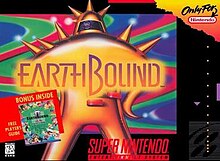
Back ايرث باوند Arabic ايرث باوند ARZ EarthBound Esperanto EarthBound Spanish EarthBound Finnish EarthBound French EarthBound HE EarthBound ID EarthBound Icelandic EarthBound Italian
| EarthBound | |
|---|---|
 North American box art, depicting a Final Starman with Ness's reflection in its visor | |
| Developer(s) | Ape Inc. HAL Laboratory[a] |
| Publisher(s) | Nintendo |
| Director(s) | Shigesato Itoi |
| Producer(s) | Shigesato Itoi Satoru Iwata Tsunekazu Ishihara |
| Designer(s) | Akihiko Miura |
| Programmer(s) | Satoru Iwata Kouji Malta |
| Artist(s) | Kouichi Ooyama |
| Writer(s) | Shigesato Itoi |
| Composer(s) | Keiichi Suzuki Hirokazu Tanaka |
| Series | Mother |
| Platform(s) | Super NES Game Boy Advance |
| Release | Mother 1+2
|
| Genre(s) | Role-playing |
| Mode(s) | Single-player |
EarthBound, released in Japan as Mother 2: Gīgu no Gyakushū,[b][1][2] is a role-playing video game developed by Ape Inc. and HAL Laboratory and published by Nintendo for the Super Nintendo Entertainment System. The second entry in the Mother series, it was first released in Japan in August 1994, and in North America in June 1995. A port for the Game Boy Advance developed by Pax Softnica, bundled with Mother (1989) as Mother 1+2, was released only in Japan in 2003.[3] As Ness and his party of Paula, Jeff and Poo, the player travels the world to collect melodies from eight Sanctuaries in order to defeat the universal cosmic destroyer Giygas.
EarthBound had a lengthy development period that spanned five years. Its returning staff from Mother (1989) included writer/director Shigesato Itoi and lead programmer Satoru Iwata, as well as composers Keiichi Suzuki and Hirokazu Tanaka, who incorporated a diverse range of styles into the soundtrack, including salsa, reggae, and dub. Most of the other staff members had not worked on the original Mother, and the game came under repeated threats of cancellation until Iwata joined the team. Originally scheduled for release in January 1993, the game was completed around May 1994.
Themed around an idiosyncratic portrayal of Americana and Western culture, EarthBound subverted popular role-playing game traditions by featuring a modern setting while parodying numerous staples of the genre. Itoi wanted the game to reach non-gamers with its intentionally goofy tone; for example, the player uses items such as the Pencil Eraser to remove pencil statues, experiences in-game hallucinations, and battles piles of vomit, taxi cabs, and walking nooses. For its American release, the game was marketed with a $2 million promotional campaign that sardonically proclaimed "This game stinks". The game's puns and humor were reworked by localizer Marcus Lindblom. Since the original Mother had not yet been released outside Japan, Mother 2 was called EarthBound to avoid confusion about what it was a sequel to.
Although it was positively received by Japanese audiences, EarthBound sold poorly in the United States, which journalists attributed to a combination of its simple graphics, satirical marketing campaign, and a lack of market interest in the genre. In the ensuing years, a dedicated fan community spawned that advocated for the series' recognition, particularly after Ness appeared as a playable character in the Super Smash Bros. series. By the 2000s, multiple reader polls and critics had named it one of the greatest video games ever made, and it became regarded as a "sacred cow among gaming's cognoscenti".[4] It was followed by the Japan-only sequel Mother 3 for the Game Boy Advance in 2006. EarthBound was later made available worldwide on the Wii U Virtual Console in 2013, 3DS Virtual Console in 2016, the SNES Classic in 2017, and Nintendo Switch Online in February 2022.
Cite error: There are <ref group=lower-alpha> tags or {{efn}} templates on this page, but the references will not show without a {{reflist|group=lower-alpha}} template or {{notelist}} template (see the help page).
- ^ "MOTHER2 ギーグの逆襲/EarthBound / ハル研究所". HAL Laboratory. Archived from the original on November 11, 2021. Retrieved August 7, 2017.
- ^ "MOTHER2 ギーグの逆襲". Nintendo (in Japanese). Archived from the original on November 11, 2021. Retrieved August 7, 2017.
- ^ ""Game Boy Advance March 2001 - January 2005 Releases Section"". www.nintendo.co.jp. Archived from the original on April 7, 2023. Retrieved July 4, 2023.
- ^ Cite error: The named reference
Eurogamer: M3 reviewwas invoked but never defined (see the help page).
© MMXXIII Rich X Search. We shall prevail. All rights reserved. Rich X Search